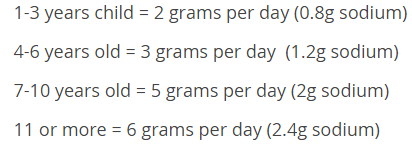Sodium is important for healthy bodily functions. It balances fluids in the body, is needed for muscle contractions, helps send nerve impulses, and influences blood pressure. However, it is important to avoid consuming too much sodium because it can raise blood pressure that leads to several cardiovascular complications.Hypertension can lead to kidney disease, heart disease, and congestive heart failure. The problem is that most people do not know exactly how much is too much.
How Much Sodium Is Too Much?

As per the Dietary Guidelines for Americans, it is important to consume less than 2,300mg of sodium a day. You should keep it close to 1,500mg if you are 51 years of age or older, have risks for high blood pressure, heart or kidney diseases. You need to limit your salt intake also if you are black or if you already have diabetes, or chronic kidney diseases. Do not aim for upper limit when it comes to deciding how much sodium is too much. As for children, the limit of sodium in the form of salt is:

Why Is Balanced Sodium Important for Our Body?
While too much sodium can cause some complications, you cannot do without it. Sodium has to be there in your diet for the body to function well. Salt and other minerals help regulate fluids and facilitate your body to understand when to dispose of water. Sodium is also essential for muscle contraction and nerve transmission.
Here is more about the effects of sodium on your body:
- Brain: Research shows that high-sodium intake leads to cognitive decline. Although it is not clear why sodium is detrimental to the brain, it definitely leaves negative effects on cognitive function, especially when the individual has a sedentary lifestyle.
- Kidneys: Sodium signals the kidneys to regulate the amount of water it should retain. A high-sodium diet can disturb this delicate balance and ultimately reduces kidney function. Consuming too much of sodium may also increase your risk of developing kidney stones.
- Bones: Any reduction in kidney function may also lead to excessive calcium excretion through urination. This makes your bones rather thin and increases your risk for osteoporosis.
- Heart: Not knowing how much sodium is too much may lead to excessive fluid retention that may lead to high blood pressure. This can lead to serious conditions such as heart failure and stroke. Reducing salt intake may help lower your blood pressure.
- Skin: Consuming high-sodium food may lead to edema that causes swelling in the arms, hands, feet, legs, and ankles.
- Stomach: Some evidence is there to support the idea that excessive salt consumption may cause stomach cancer. It may also cause stomach ulcers, which is mainly because sodium can leave negative effects on the mucous lining of the stomach and damage its tissue.
The Main Sources of Sodium
The most common form of sodium is sodium chloride otherwise known as table salt. Other forms are baking soda (sodium bicarbonate), sodium cyclamate (sweetener), sodium benzoate (preservative), and sodium nitrate (preservative). A teaspoon of table salt contains 2,300mg of sodium, whereas a teaspoon of baking soda contains about 1,000mg of sodium.
The average American consumes about 3,400 mg of sodium every day, which is higher than recommended. The major sources of sodium in your diet include:
- Processed and prepared foods: The most common types of processed foods are prepared dinners such as meat, pasta, and egg dishes. Other common choices are cold nuts, pizza, cheese, soups, and fast foods.
- Natural sources: Some foods are rich in sodium, such as vegetables as well as dairy products, shellfish, and meat. Eating these foods will increase your sodium intake. You sometimes get sodium from unexpected sources. For instance, a cup of low-fat milk contains about 100mg of sodium.
- In the kitchen: You will find several recipes that require a good amount of salt. Several condiments may also have sodium. A tablespoon of soy sauce, which otherwise looks harmless, contains about 1,000 mg of sodium.
How to Maintain a Low Sodium Diet
Once you know how much sodium is too much,it is important to take steps to maintain a low sodium diet. The following steps will help:
- Always read the label to check the nutrition facts of everything your purchase. Compare sodium in different brands of foods such as packaged soups, frozen meals, dressings, breads, and snacks to opt for the ones with lower sodium content. Make sure sodium content on the label is less than 140 milligrams per serving or 500 milligrams per meal.
- Avoid buying packaged food and prepare your own food if possible. This helps you take full control of how much salt you consume.
- Make use of herbs and spices instead of using salt to add flavor to your food. Basil, oregano, rosemary, ginger, cayenne pepper, garlic powder, and fresh garlic are some great choices.
- Buy fresh pork, poultry, and lean meat and avoid smoked, canned, and processed meats like sausages, meats, and corned beef to limit your salt intake.
- Eat vegetables that are low in sodium. Always buy fresh or no-salt-added canned veggies.
- Use sodium-containing canned food, such as veggies, tuna, and beans after giving them a proper rinse.
- Opt for low-fat or fat-free milk products, including fortified soy beverages, yogurt, and cheese instead of processed cheese products.
- Pay attention to your condiments because they may also contain loads of sodium. Choose reduced sodium soy sauce and use a small amount of seasoning when needed.
- Insist on seeing the nutrition information when eating out in restaurants. Always choose a lower-sodium option, especially if you already have hypertension.
